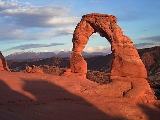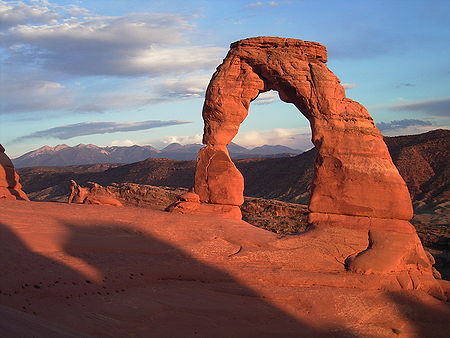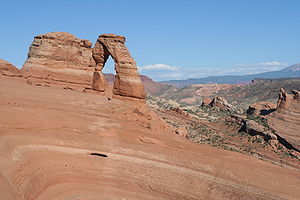
Delicate Arch
Encyclopedia

Natural arch
A natural arch or natural bridge is a natural geological formation where a rock arch forms, with an opening underneath. Most natural arches form as a narrow ridge, walled by cliffs, become narrower from erosion, with a softer rock stratum under the cliff-forming stratum gradually eroding out until...
located in Arches National Park
Arches National Park
Arches National Park is a U.S. National Park in eastern Utah. It is known for preserving over 2000 natural sandstone arches, including the world-famous Delicate Arch, in addition to a variety of unique geological resources and formations....
near Moab, Utah
Moab, Utah
Moab is a city in Grand County, in eastern Utah, in the western United States. The population was 4,779 at the 2000 census. It is the county seat and largest city in Grand County. Moab hosts a large number of tourists every year, mostly visitors to the nearby Arches and Canyonlands National Parks...
.
It is the most widely-recognized landmark
Landmark
This is a list of landmarks around the world.Landmarks may be split into two categories - natural phenomena and man-made features, like buildings, bridges, statues, public squares and so forth...
in Arches National Park and is depicted on Utah license plates
Vehicle registration plates of Utah
The U.S. state of Utah first required its residents to register their motor vehicles and display license plates in 1915. A gallery of license plates from 1915 to 1974 can be found .- Passenger baseplates 1985 to present :- 2008 to present :...
and on a postage stamp
Postage stamp
A postage stamp is a small piece of paper that is purchased and displayed on an item of mail as evidence of payment of postage. Typically, stamps are made from special paper, with a national designation and denomination on the face, and a gum adhesive on the reverse side...
commemorating Utah's centennial anniversary of statehood in 1996. The Olympic torch relay
2002 Winter Olympics torch relay
The 2002 Winter Olympics torch relay was a 65 day run, from December 4, 2001 to February 8, 2002, prior to the 2002 Winter Olympics. The runners carried the Olympic Flame throughout the United States - following its lighting in Olympia, Greece to the opening ceremony of the 2002 games at...
for the 2002 Winter Olympics
2002 Winter Olympics
The 2002 Winter Olympics, officially the XIX Olympic Winter Games, were a winter multi-sport event that was celebrated in February 2002 in and around Salt Lake City, Utah, United States. Approximately 2,400 athletes from 77 nations participated in 78 events in fifteen disciplines, held throughout...
passed through the arch.
History
Because of its distinctive shape, the arch was known as "the Chaps" and "the Schoolmarm's Bloomers" by local cowboys. It was given its current name by Frank Beckwith, leader of the Arches National Monument Scientific Expedition, who explored the area in the winter of 1933–1934. (The story that the names of Delicate Arch and Landscape ArchLandscape Arch
Landscape Arch is the longest of the many natural rock arches located in the Arches National Park in Utah, USA. The arch is among many in the area known as Devil's Garden in the north area of the park...
were inadvertently exchanged due to a signage mixup by the National Park Service
National Park Service
The National Park Service is the U.S. federal agency that manages all national parks, many national monuments, and other conservation and historical properties with various title designations...
is false.)
This arch played no part in the original designation of the area as a U.S. National Monument
U.S. National Monument
A National Monument in the United States is a protected area that is similar to a National Park except that the President of the United States can quickly declare an area of the United States to be a National Monument without the approval of Congress. National monuments receive less funding and...
in 1929, and was not included within the original boundaries; it was added when the monument was enlarged in 1938.
In the 1950s, the National Park Service investigated the possibility of applying a clear plastic
Plastic
A plastic material is any of a wide range of synthetic or semi-synthetic organic solids used in the manufacture of industrial products. Plastics are typically polymers of high molecular mass, and may contain other substances to improve performance and/or reduce production costs...
coating to the arch to protect it from further erosion
Erosion
Erosion is when materials are removed from the surface and changed into something else. It only works by hydraulic actions and transport of solids in the natural environment, and leads to the deposition of these materials elsewhere...
and eventual destruction. The idea was ultimately abandoned as impractical and contrary to NPS principles.
The Delicate arch is reachable by heading into a small pickup trail down the entrance path entering the park.
Geology
Delicate Arch is formed of Entrada SandstoneEntrada Sandstone
The Entrada Sandstone is a formation in the San Rafael Group that is spread across the U.S. states of Wyoming, Colorado, northwest New Mexico, northeast Arizona and southeast Utah...
. The original sandstone fin was gradually worn away by weathering and erosion, leaving the arch. Other arches in the park were formed the same way but due to placement and less dramatic shape are not as famous.
Hiking to the Arch

Wolfe Ranch
The Wolfe Ranch, also known as Turnbow Cabin, is located in Arches National Park near Moab, Utah, U.S.John Wesley Wolfe settled in the location in 1888 with his oldest son Fred. A nagging leg injury from the Civil War prompted Wolf to move west from Ohio, looking for a drier climate...
. Taking thirty to forty-five minutes each way, the round trip is slightly more than 3 mi (4.8 km) long and the Arch is completely hidden from view on most of this trail.
The first third of the hike is through rugged, brushy terrain and gains slightly in elevation. The middle third of the hike is along the face of an exposed slickrock outcrop and is strenuous due to the gain in elevation, but offers better views of the geology
Geology
Geology is the science comprising the study of solid Earth, the rocks of which it is composed, and the processes by which it evolves. Geology gives insight into the history of the Earth, as it provides the primary evidence for plate tectonics, the evolutionary history of life, and past climates...
in the salt valley. Cairn
Cairn
Cairn is a term used mainly in the English-speaking world for a man-made pile of stones. It comes from the or . Cairns are found all over the world in uplands, on moorland, on mountaintops, near waterways and on sea cliffs, and also in barren desert and tundra areas...
s (piles of rocks) have been placed by visitors and park staff to roughly suggest the otherwise unmarked trail to the top, yet visitors tend to wander all over the huge expanse of completely exposed sandstone
Sandstone
Sandstone is a sedimentary rock composed mainly of sand-sized minerals or rock grains.Most sandstone is composed of quartz and/or feldspar because these are the most common minerals in the Earth's crust. Like sand, sandstone may be any colour, but the most common colours are tan, brown, yellow,...
.
The latter third of the trail is the most rugged, nearing the top of the plateau. The Arch is not yet visible, and the trail runs around outcrops, through washes and between stands of twisted brush and trees. The trail may be easier to follow, but meanders as parts become muddy and difficult to walk through. During the 2004 fall season, the trail clearly followed the left (northern) side of the plateau, and brought visitors along a narrow shelf nearly 150 ft (45.7 m) above a dry wash.
The arch comes into view suddenly around a corner in the trail and frames the La Sal Mountains
Manti-La Sal National Forest
The Manti-La Sal National Forest covers 1,270,646 acres and is located in the central and southeastern parts of the U.S. state of Utah and the extreme western part of Colorado...
to the southeast. The immediate area around the Arch offers views of the southern expanse of the park, and has unguarded cliffs plunging one hundred feet or more.
Wildlife
During the summer months, White-throated SwiftWhite-throated Swift
The White-throated Swift is a swift of the family Apodidae native to western North America, south to cordilleran western Honduras...
s (Aeronautes saxatalis) nest in the top of the arch.
Controversy
Nature photographer Michael Fatali started a fire under the arch in September 2000 to demonstrate nighttime photography techniques to a group of amateur photographers. The fire discolored portions of the sandstone near the arch. Fatali was placed on probation and fined $10,900 in restitution to the National Park ServiceNational Park Service
The National Park Service is the U.S. federal agency that manages all national parks, many national monuments, and other conservation and historical properties with various title designations...
for the cost of cleanup efforts.
In May 2006, climber Dean Potter
Dean Potter
Dean Potter is an American free climber, alpinist, BASE jumper, BASEliner, and highliner. He is noted for hard first ascents, free solo ascents, speed ascents, and enchainments in Yosemite and Patagonia....
made the first recorded free solo (no ropes or protection) ascent of this formation. Climbing Delicate Arch was not explicitly forbidden under the rules in force at the time. It was understood, however, that the named-arch formations should not be climbed. The Park Service has since closed the loophole by disallowing climbs on any named arch within the park year-round. Slacklining
Slacklining
Slacklining is a practice in balance that typically uses 1 inch nylon webbing tensioned between two anchor points. Slacklining is distinct from tightrope walking in that the line is not held rigidly taut ; it is instead dynamic, stretching and bouncing like a long and narrow trampoline...
and the placement of new fixed anchors on new climbs is also prohibited. Controversy erupted when photographs taken after Potter's climb appeared to show damage caused by a climbing technique called top roping
Top roping
Top-rope climbing is a style in climbing in which a rope, used for the climber's safety, runs from a belayer at the foot of a route through one or more carabiners connected to an anchor system at the top of the route and back down to the climber, usually attaching to the climber by means of a...
. Potter has stated on several occasions that he never top-roped the Arch and no photos exist of Potter using a top rope setup on the Arch. It is possible that a previous climber had top-roped the Arch leaving the rope scars.
Gallery
Image:USA 10400 Arches National Park Luca Galuzzi 2007.jpg
Image:USA 10399 x10401 Arches National Park Luca Galuzzi 2007.jpg
Image:Delicate Arch 2005 09 04 sunset.JPEG
Image:USA Arches NP Delicate Arch(1).jpg
Image:Arch.usa.arp.750pix.jpg
Image:DelicateArch1_GB.jpg
Image:Parque Nacional de los-Arcos-Utah2509.JPG

